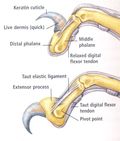 If you look for information on cat claws, most of what you find is devoted either to the mechanics of the retractable claw or to the pros and cons (or evils, depending on your degree of zeal) of the de-clawing operation. Google up pictures of the claw anatomy, and you get stuff like this. But, to quote (sort of) Arlo Guthrie, "…that's not what I came here to talk about."
If you look for information on cat claws, most of what you find is devoted either to the mechanics of the retractable claw or to the pros and cons (or evils, depending on your degree of zeal) of the de-clawing operation. Google up pictures of the claw anatomy, and you get stuff like this. But, to quote (sort of) Arlo Guthrie, "…that's not what I came here to talk about."
 People often talk about a cat "sharpening" its claws. You have to wonder how that works. You know that the cat is not sitting there with a whet-stone, working the claw down to a needle-sharp point. On the other hand, you also know that the claws generally do have a needle-sharp point… or should I say razor-sharp? How does that work?
People often talk about a cat "sharpening" its claws. You have to wonder how that works. You know that the cat is not sitting there with a whet-stone, working the claw down to a needle-sharp point. On the other hand, you also know that the claws generally do have a needle-sharp point… or should I say razor-sharp? How does that work?
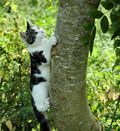 Just walking around doesn't require sharp claws. In fact, it doesn't require claws at all. They walk on the next bone up, with the third phalanx retracted up out of the way (as in the top picture). The needle-sharp point is taking no wear. The cat does benefit from sharp claws when climbing trees. They climb trees to escape bigger predators, as well as to gain access to prey themselves. This is bound to put some wear and tear on the claws, dulling them down.
Just walking around doesn't require sharp claws. In fact, it doesn't require claws at all. They walk on the next bone up, with the third phalanx retracted up out of the way (as in the top picture). The needle-sharp point is taking no wear. The cat does benefit from sharp claws when climbing trees. They climb trees to escape bigger predators, as well as to gain access to prey themselves. This is bound to put some wear and tear on the claws, dulling them down.
 Then, when you move in for the kill (or to slap an unwary veterinarian), and out pops the switchblade, you'll be wanting some claws that can really penetrate deeply with no trouble. Dull claws just won't get it when you are the deadly feline hunter/fighter. If you're hunting, climbing and fighting, they are bound to wear down. So, how do you sharpen them?
Then, when you move in for the kill (or to slap an unwary veterinarian), and out pops the switchblade, you'll be wanting some claws that can really penetrate deeply with no trouble. Dull claws just won't get it when you are the deadly feline hunter/fighter. If you're hunting, climbing and fighting, they are bound to wear down. So, how do you sharpen them?
We see the cat on the scratching post (or your furniture, alas) just working away. "He needs to sharpen his claws." I see how that destroys the furniture, but how could it be sharpening his claws?
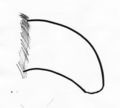 After all that hunting, climbing, slapping and destruction of the furniture, it would appear that the claw would be worn down like this. And it is, and it would stay that way if the cat's claws grew lengthwise like a dog's claws or a person's fingernails. That's not the way cat claws grow, though. They don't grow lengthwise. They grow in layers like an onion (surely you don't need a picture of an onion).
After all that hunting, climbing, slapping and destruction of the furniture, it would appear that the claw would be worn down like this. And it is, and it would stay that way if the cat's claws grew lengthwise like a dog's claws or a person's fingernails. That's not the way cat claws grow, though. They don't grow lengthwise. They grow in layers like an onion (surely you don't need a picture of an onion).
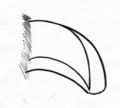 Thus, as the claw is wearing down on the outside, a brand-new, needle-sharp (or razor-sharp) claw is growing inside. This is why trimming cat toe-nails doesn't give you a long-lasting short, smooth nail. It won't be long before the outer sheath you trimmed is shed, revealing the brand-new weapon, ready for action.
Thus, as the claw is wearing down on the outside, a brand-new, needle-sharp (or razor-sharp) claw is growing inside. This is why trimming cat toe-nails doesn't give you a long-lasting short, smooth nail. It won't be long before the outer sheath you trimmed is shed, revealing the brand-new weapon, ready for action.
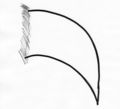 The "sharpening" of the claw is actually the removal of those worn outer sheaths. As the new inner claw reaches full development, the outer sheath becomes a little loose and a little uncomfortable. The cat keeps working on something like tree bark, or your furniture, until he gets it pried off, and he's ready to rumble again. Of course, some cats just tear up your furniture for the hell of it, like Garfield, but the cat actually does need to scratch.
The "sharpening" of the claw is actually the removal of those worn outer sheaths. As the new inner claw reaches full development, the outer sheath becomes a little loose and a little uncomfortable. The cat keeps working on something like tree bark, or your furniture, until he gets it pried off, and he's ready to rumble again. Of course, some cats just tear up your furniture for the hell of it, like Garfield, but the cat actually does need to scratch.
 Which brings us to Bob. Bob used to be outside a lot. Unfortunately, with advancing age and a plague of stray dogs, his owners felt like he might not be safe outside anymore, and he had to become a total house-cat. He came in recently because he was chewing on his feet all the time. The owners just couldn't understand what was bothering him. He never used to do this.
Which brings us to Bob. Bob used to be outside a lot. Unfortunately, with advancing age and a plague of stray dogs, his owners felt like he might not be safe outside anymore, and he had to become a total house-cat. He came in recently because he was chewing on his feet all the time. The owners just couldn't understand what was bothering him. He never used to do this.
While Bob was outside, he loved to scratch on tree-bark. Since he's been inside, he doesn't scratch on anything. Not on the furniture, not on the lovely scratching-posts they bought him. With older cats, those old claw sheaths don't shed as easily as with younger cats. Occasionally, we'll find an old cat where several layers have accumulated. Bob is the champion in this department.
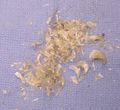 This pile of claw sheaths (and pieces thereof) are the product of one toe-nail trim… and a lot of picking away at the outer sheaths by me. His feet looked pretty normal afterward, and he quit chewing on them. I can't really imagine what that must feel like with all those extra claw-layers jammed up in your toe. (Ingrown toenails, anyone?)
This pile of claw sheaths (and pieces thereof) are the product of one toe-nail trim… and a lot of picking away at the outer sheaths by me. His feet looked pretty normal afterward, and he quit chewing on them. I can't really imagine what that must feel like with all those extra claw-layers jammed up in your toe. (Ingrown toenails, anyone?)
Bob is scheduled for monthly toe-nail trims (or inspections at least). I've recommended getting a log with the bark still on for his new scratching post. We'll see if that takes care of it.


Very interesting. Nice to know there’s a real purpose other than tearing up furniture. 🙂
Very interesting content here! I knew all this but it’s explained so well and so clearly it just makes sense all over again.
Well described. Goodjob my man. He was a very patient cat too for you to be tugging on his nails as you were.
A well worded description of the concept with most appropriate diagrams and pics. Thank you, and your sense of humour is also very pleasing. With an extra few descriptions of genetic and evolutionary insight, this is definitely textbook material.
Dittos to the complimentary comments posted May 05, 2011 at 07:44 PM! To quote: “A well worded description of the concept with most appropriate diagrams and pics. Thank you, and your sense of humour is also very pleasing. With an extra few descriptions of genetic and evolutionary insight, this is definitely textbook material.”
OMG, that pile from one trimming? Forgive me but I’m trying to get my head around that one. How long after Bob became an inside cat did you wait before you did the trim? I hope that you get alerts when you get a new comment and that you’ll get back to me. My older cat (13, indoor ONLY) has mysteriously quit sharpening her claws I think. First thing I noticed was that she was getting her nails caught on the bedspread A LOT. Occasional occurrences are normal. But I’m talking like every step or every other step. I haven’t seen her sharpen for some time (month) yet a few claws are sharp so maybe she’s become a closet shredder. I’ve never tried to stop her from doing it on anything so she’s not gun shy. I said some of them because they are different lengths. A couple are actually so long that they are curling under and where that’s headed is obvious. Any thoughts?
Hello, Ingrid,
I’m not sure how long Bob had been indoors before they realized he had a problem.
Your note about different lengths suggests that your cat needs a nail trim right away. It is hard to say how often the nails will need attention. When they look long or thick, things are not working normally.
Typically the front claws are a bit longer and more curved than the back claws. However the claws on the back paws should all be about the same size, and all the front claws should be about the same size.
The claws that “don’t match” are having a problem.
I have a couple of patients like Bob, only the others don’t have every nail affected like he does. I trim their claws even with the foot-pad, then pick off the extra sheaths with my fingernails. So far none of them have required sedation, but they do protest some. They really seem to resent the picking at the excess sheaths.
Time for a toe-nail trim.
My beloved Nala is twenty years old now and doesn’t scratch any more. I trim her claws but I need a detailed description on how to pick off the old sheaths. She is too old to be safely sedated .
Hello, Maggie,
I just use my fingernails and start at the outer edge underneath the claw and pick at it. Once you get a couple of the outer sheaths off, you’ll see a more normal-looking claw underneath.
nice information.
so cats need sharpened claws to ride on the trees. happy to know this information
Very useful. Thank you ????
Very useful. Thank you very much!